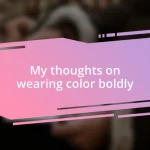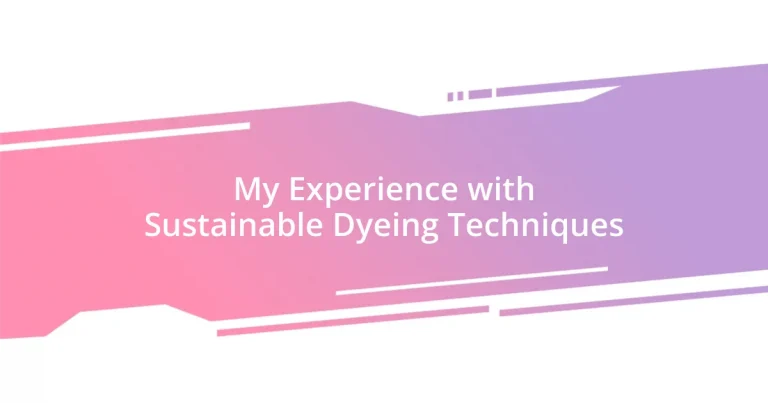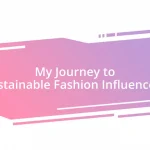Key takeaways:
- Sustainable dyeing techniques utilize natural sources to minimize environmental impact, showcasing a variety of colors derived from everyday items like plants and food waste.
- Preparation is crucial for successful dyeing; thorough washing, proper mordanting, and testing swatches can significantly affect the vibrancy and longevity of the colors.
- Eco-friendly practices, such as sourcing locally, reusing dye baths, and using natural fixatives, enhance the dyeing process while promoting sustainability and connection to the environment.
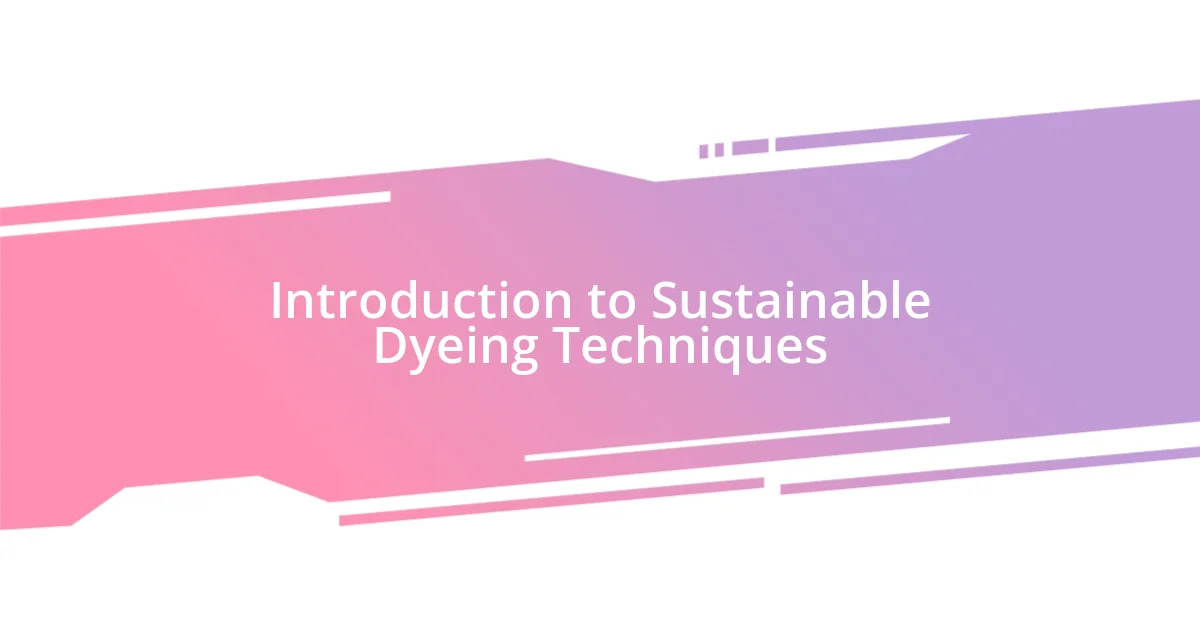
Introduction to Sustainable Dyeing Techniques
Sustainable dyeing techniques have gained significant attention in recent years, reflecting growing concerns about the environmental impact of conventional dyeing processes. I still remember the first time I learned about the toxic chemicals typically used in dyeing. It was a real eye-opener that made me question the origins of the colors that brighten my wardrobe.
Exploring natural dyes, like those derived from plants or insects, has been an exciting journey for me. It’s fascinating to think that a simple flower or leaf can create such vibrant hues! Have you ever tried dyeing fabric with turmeric? The golden yellow it produces is not only beautiful but also a reminder that nature provides us with stunning alternatives.
As I delved deeper, I discovered that sustainable dyeing isn’t just about the materials but also about conserving water and energy. The emotional connection I felt while experimenting with eco-friendly methods was profound. It’s as if every dye bath tells its own story, linking me to both the environment and the craftsmanship of artisans from around the world.
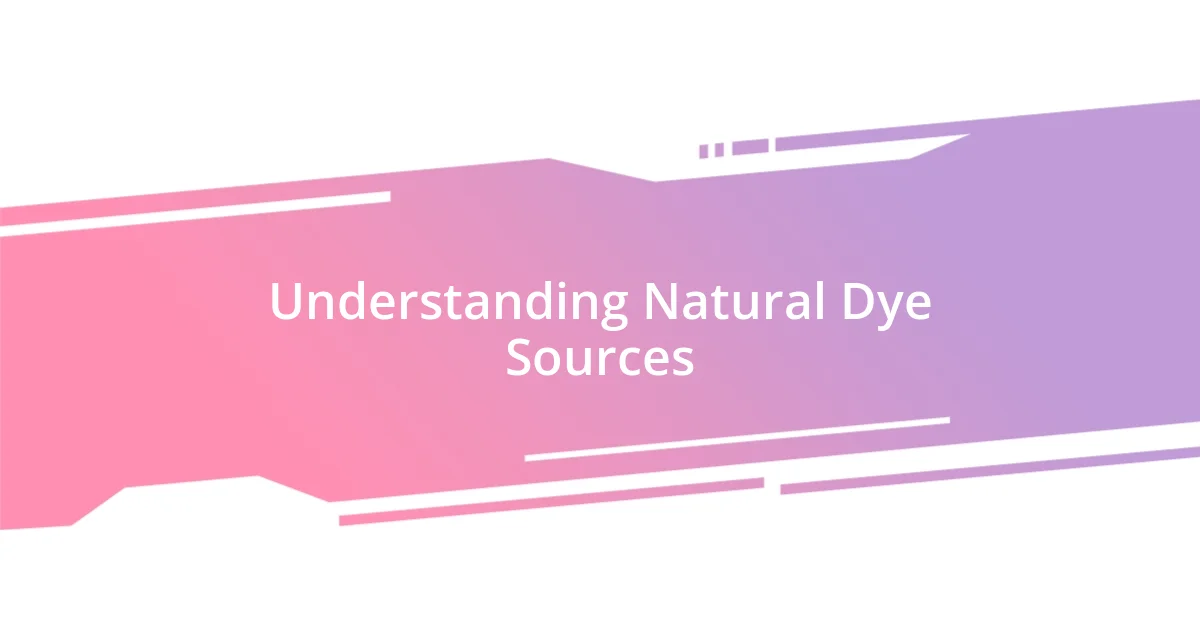
Understanding Natural Dye Sources
Understanding the sources of natural dyes has been an enlightening aspect of my exploration. I vividly recall a trip to a local farmers’ market where I stumbled upon a vendor selling indigo plants. Just the sight of those vibrant leaves inspired me to experiment further. It was astonishing to learn that indigo can produce a range of blues, depending on how it is processed. Have you seen the incredible transformation when leaf to dye happens? It’s almost like magic!
As I dove into the world of natural dyes, I was consistently surprised by how many beautiful colors can be extracted from everyday items. For instance, I remember one afternoon, I decided to experiment with avocado pits and skins. The soft peach tones that emerged were stunning! Who would have thought that something I normally toss away could create such a lovely shade? Each experiment felt like a small step toward rediscovering nature’s palette, tying me closer to the earth.
The variety of natural dye sources truly amazes me. Not only do they offer a spectrum of colors, but each source also carries its own story and cultural significance. I found it deeply meaningful to learn about the historical uses of certain plants in indigenous cultures. Understanding these connections has enriched my dyeing practice, reinforcing the importance of sourcing and sustainability.
| Dye Source | Color Produced |
|---|---|
| Indigo | Blue |
| Turmeric | Yellow |
| Avocado | Soft Peach |
| Madder Root | Red |
| Eucalyptus Leaves | Soft Green |
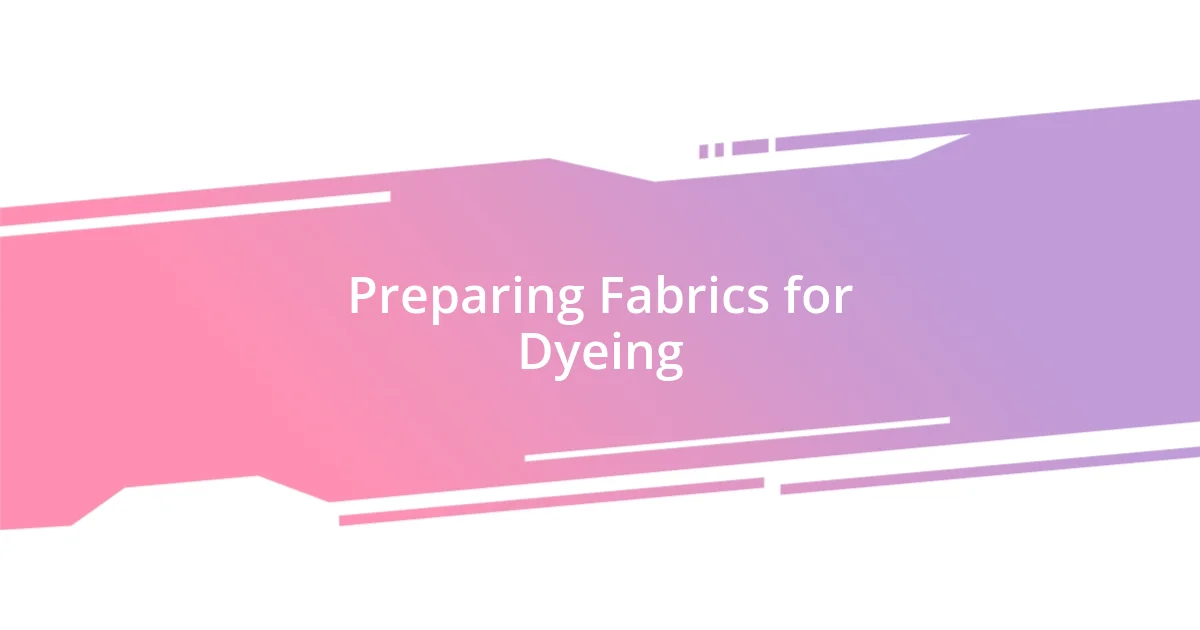
Preparing Fabrics for Dyeing
Preparing fabrics for dyeing is a crucial step that can significantly influence the outcome of your project. I still remember the excitement I felt the first time I prepped my fabric. I had just returned from a nature walk, armed with fresh marigolds, and wanted the fabric to soak in as much of the color as possible. Pre-treating the fabric to help it absorb dye really makes a difference. Not only does it help in achieving vibrancy, but it also ensures the longevity of the color, something that I cherish after my own experiences.
Here’s a quick checklist for preparing fabrics for dyeing:
- Choose the Right Fabric: Natural fibers like cotton, silk, or wool work best with natural dyes.
- Wash Fabric Thoroughly: Remove any finishes, dirt, or oils that might hinder dye absorption.
- Mordanting (if applicable): Use mordants like alum or vinegar to enhance color uptake and fix the dye to the fabric.
- Soak Before Dyeing: Pre-soak your fabric in warm water to expand the fibers, allowing for deeper color penetration.
- Test Swatches: Always dye a small sample first to see how the fabric reacts with the dye.
As I reflect on my own journey, each time I prepared a new fabric, there was a blend of anticipation and a hint of nervousness. I remember a particular instance where I forgot to wash the fabric beforehand. The results were lackluster, and it was such a disappointment! This moment taught me the importance of preparation in achieving those vibrant, rich colors I sought. I hope you’ll be more mindful than I was, as the preparation truly sets the stage for your sustainable dyeing adventure!
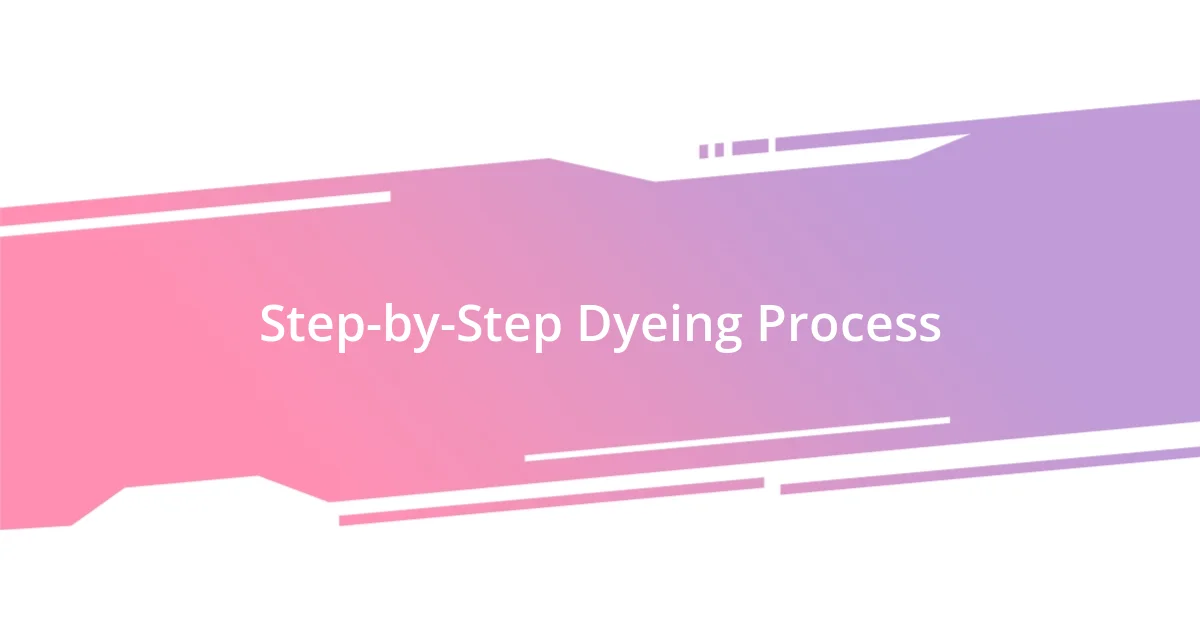
Step-by-Step Dyeing Process
Dyeing is a hands-on process, and I find that following a clear step-by-step method really enhances the experience and outcome. First, gather your natural dye materials and prepare your fabric as previously mentioned. As I learned, the excitement builds when you begin the actual dyeing. I vividly remember filling a pot with water and watching as the color ingredients slowly transformed the liquid into something vibrant and alive. It’s a captivating process; have you ever just stood there, mesmerized, by the swirling colors?
Once your dye bath is ready, it’s time to immerse your fabric. I’ve often dipped the fabric into the dye at varying times, testing how long to leave it in. One memorable session involved experimenting with eucalyptus leaves, and leaving it for just the right moment made all the difference. That moment of anticipation, waiting to see how the fabric would turn out is truly electric. I encourage you to keep track of your timings and even jot them down—each batch becomes a unique creation!
After dyeing, rinsing the fabric in cool water is essential. Initially, I was startled by how much dye would rinse out, fearing I might lose the colors I had worked so hard for. However, I learned that this step helps set the dye. It’s a bit like watching your masterpiece come to life. Have you ever felt that thrill of unveiling something new? That’s how I feel every time I see the final result. Each piece tells a story, reflecting not just the colors, but also the journey of its creation.
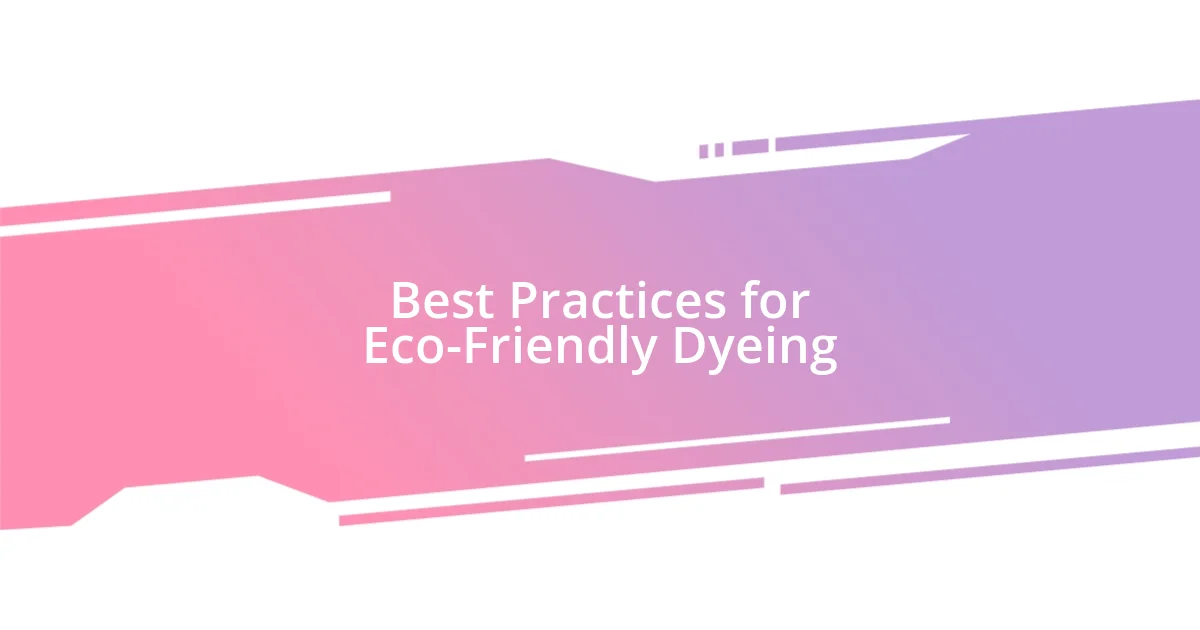
Best Practices for Eco-Friendly Dyeing
One of the best practices for eco-friendly dyeing is to source your natural dye materials locally. I can’t tell you how rewarding it is to wander through local markets or even my own backyard, looking for plants, flowers, and fruits that can transform plain fabric into a colorful masterpiece. For instance, I once stumbled upon a patch of wild blackberries, and after a quick rinse, I had a stunning wash of purple for my fabric. It felt like I was connecting with my environment in a meaningful way, not to mention the satisfaction of using what was literally right at my fingertips.
Incorporating water-saving techniques is also vital. I’ve come to appreciate the importance of reusing my dye bath whenever possible. After dyeing a piece, instead of discarding the liquid, I preserve it for future projects. One time, I used the same dye bath for several batches of fabric, gradually layering the colors. The resulting hues were richer than I had anticipated, leading me to wonder, have you ever found beauty in the unintended outcomes of a project? This practice not only conserves water but also creates unique color variations, making every piece one-of-a-kind.
Lastly, after dyeing, I prioritize setting colors with eco-friendly methods. Instead of using synthetic fixatives, I often opt for natural salt or vinegar—a trick I learned from a friend who swears by it. The first time I saw my dyed fabric’s colors stand strong after a gentle wash, I felt a rush of pride. It made me realize how much a little care in the finishing stages can go a long way. Isn’t it gratifying to know that your choices impact not just your piece but the environment as well? These simple steps reinforce my commitment to sustainable practices in dyeing, helping me create not just beautiful textiles but a healthier planet too.
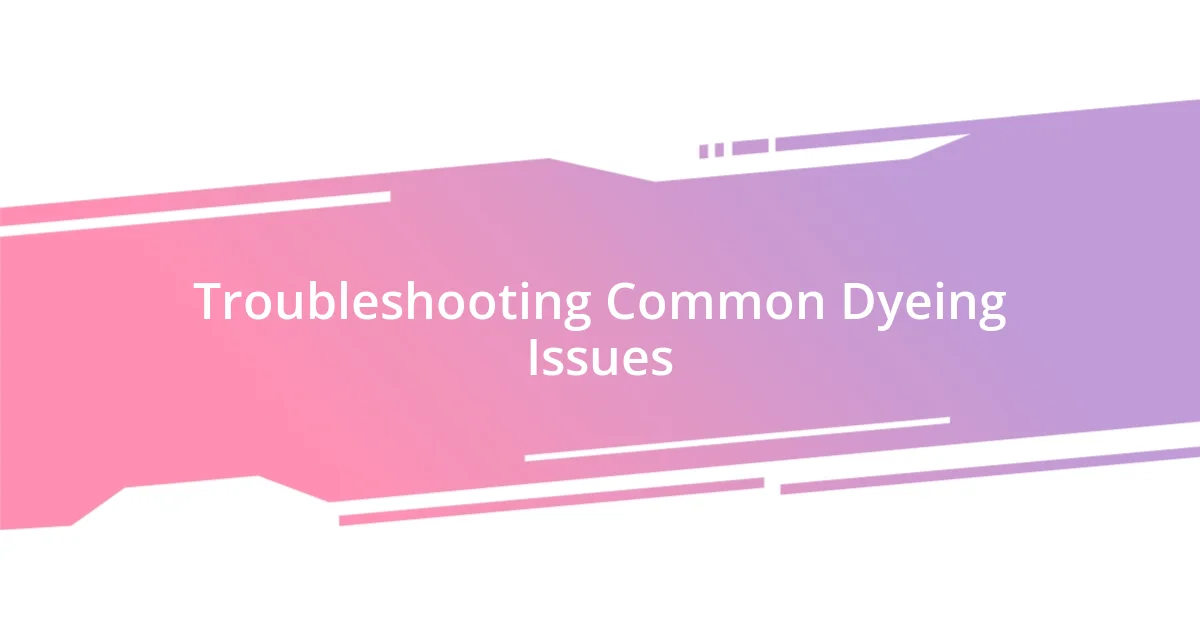
Troubleshooting Common Dyeing Issues
I’ve faced my fair share of dyeing mishaps, and trust me, they can feel disheartening. One time, I was excited to use avocado pits for a soft pink hue. However, after the dyeing process, the color turned out almost brown! It taught me the value of testing a small fabric swatch first. Have you ever experienced a moment like that, where anticipation fizzled into disappointment? The lesson is all about patience and experimenting before diving into larger projects.
Another frequent issue is uneven dye distribution, especially with larger pieces of fabric. While dyeing a large scarf with turmeric, I didn’t stir it adequately, resulting in patches that were vibrant yellow and others that were barely tinted. I remember staring at it in despair, thinking, “How did I miss that?” But this experience led me to invest in a trusty stirring stick, which ensures an even coat next time. Have you ever wished you had a do-over? I’ve learned that preparation can be your best friend, especially when it comes to achieving those even tones.
Lastly, I often worry about the fading of colors after washing. After a lackluster first wash, I was disheartened to see my brilliant indigo vanish to a dull shade. Realizing that I needed to incorporate additional setting agents into my process changed the game for me. Now, I always test various methods, whether it’s adding salt to the rinse or trying different natural fixatives. Have you found yourself losing that initial vibrancy? It’s all part of the journey, and every misstep becomes a stepping stone to mastering the art of sustainable dyeing.











